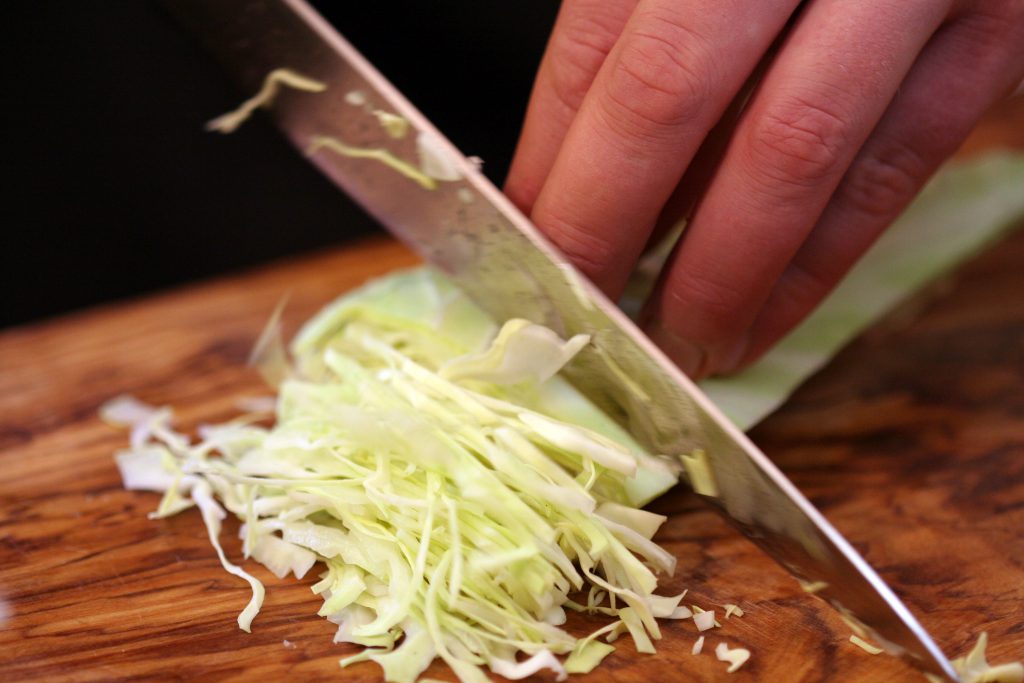
Cabbage
White cabbage is wet, crisp and refreshing with a sharp taste and aroma.
When you buy a cabbage make sure the leaves are firm, thick and shiny.
Always remove the outer leaves and the thicker veins on the outside. If you are using the cabbage in salads, sauerkraut or a stew quarter the whole head and cut the stalk out. Then you can cut up the rest as finely as necessary. If you require the leaves whole to stuff them then use a sharp knife to cut the stalk out leaving the rest of the head whole. You can then blanch the cabbage completely in boiling water. The leaves will now be easier to separate from the rest of the vegetable and will wrap around the filling without tearing. Don’t forget to peel the thicker veins here as well. Generally white cabbage doesn’t require much seasoning as it can quickly overpower the taste of the dish itself. It harmonizes well with caraway too which has the added bonus of helping to avoid bloating.
White cabbage goes well with lamb, grilled sausages and mashed potatoes. It is a also a great basis for summer salads, soups, stews and casseroles.
It will keep for up to 2 weeks in the refrigerator as long as it is kept in plastic wrap,. If you have a well ventilated cellar it is possible to keep it in a wooden box with straw underneath or hung up by the stalk for much longer. Just make sure that all cabbage heads are healthy or one might cause the whole batch to go bad!
Preparation Ideas
When you grate white cabbage put sugar and salt on it to extract the moisture.
It is particularly good with a bacon dressing. Saute some onions and bacon in a little oil and add some sugared and salted white cabbage or if you would like to try something a little more exotic how about combining it mango and papaya.
A salad with sour white cabbage is a nice variation on the menu, either as a side dish or by itself.
Take a cabbage and cut the stalk off. Chop the rest finely and grate a carrot into the mixture. Use a big carrot if the cabbage is also large. Mix the salad so that the carrot is evenly spread among the cabbage and season it with salt. At this stage you can add a bay leaf if you like as well. Put it all into a pot and squash and press it down hard and then put a wooden board or a lid on top with 4-5lbs of weight on top so that the cabbage is pressed down even more, cover it with a cloth and leave it to stand for 24 hours. Next remove the board and make some holes in the mixture so that the acid can escape. Put the board back on top of the cabbage and let it stand for a further 48 hours. The sour cabbage is then ready to serve.
Now here are a few interesting twists on the usual cabbage recipes. It is possible to season it with pepper, shallots and olive oil, but how about with some apple, nuts or even raisins.
Cole Slaw is a classic recipe and is a great accompaniment for barbecued meats. Chop up the white cabbage finely and grate in 2-3 carrots depending on the size of the cabbage. For the dressing take 1tsp flour and some olive in a pan and stir the fluid continuously for 2-3 minutes. The add 1tsp of mustard, some Tabasco and about 2tbs sugar and mix it all up. Add ½ cup of cream and 1egg yolk and add it to the rest of the mixture. Heat the dressing while stirring continuously until it thickens. When the dressing has cooled down add it to the salad and let it stand for at least 2 hours in the refrigerator before serving.
Cabbage Rolls
To prepare cabbage leaves for stuffing they need to be blanched first. You can peel the leaves off the cabbage head raw or blanch the whole head before separating the single leaves. The raw leaves are more difficult to take off without ripping so try to buy a cabbage that is not as tightly packed. Generally you will be able to use between 8-12 leaves for filling. Blanch them and cut the thicker veins flat with a sharp knife.
If you want to blanch the entire head there is a better chance of removing the leaves without ripping them. Take a big pot of boiling salt water and put the cabbage in with the stalk at the top. After a few minutes push a fork into the stalk so that it is easier to hold when removing the leaves. Use some tongs to take the leaves off one by one. Put the head back into the water and wait again a few minutes until the next layer can be removed. Carry on until you have enough leaves to fill. The veins of the leaves can be rolled flat with the back of a spoon.
To keep the leaves tightly closed when cooking lay the filling on the vein end of the leaf. Roll the filling into it and If necessary cut into the leaves on both sides. Leave at least 1½in free at the edge of the leaf and roll it in so that the filling stays inside, starting from the bottom.

Schreibe einen Kommentar